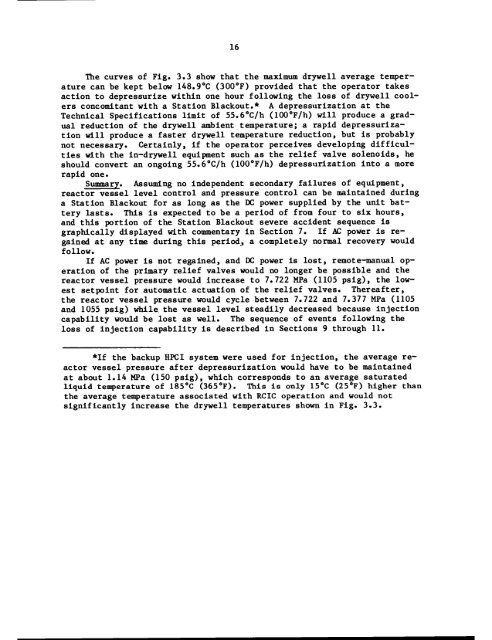Station blackout at Browns Ferry Unit One - Oak Ridge National ...
Station blackout at Browns Ferry Unit One - Oak Ridge National ...
Station blackout at Browns Ferry Unit One - Oak Ridge National ...
Create successful ePaper yourself
Turn your PDF publications into a flip-book with our unique Google optimized e-Paper software.
16<br />
The curves of Fig. 3.3 show th<strong>at</strong> the maximum drywell average temper<br />
<strong>at</strong>ure can be kept below 148.9°C (300°F) provided th<strong>at</strong> the oper<strong>at</strong>or takes<br />
action to depressurize within one hour following the loss of drywell cool<br />
ers concomitant with a <strong>St<strong>at</strong>ion</strong> Blackout.* A depressuriz<strong>at</strong>ion <strong>at</strong> the<br />
Technical Specific<strong>at</strong>ions limit of 55.6°C/h (100°F/h) will produce a grad<br />
ual reduction of the drywell ambient temper<strong>at</strong>ure; a rapid depressuriza<br />
tion will produce a faster drywell temper<strong>at</strong>ure reduction, but is probably<br />
not necessary. Certainly, if the oper<strong>at</strong>or perceives developing difficul<br />
ties with the in-drywell equipment such as the relief valve solenoids, he<br />
should convert an ongoing 55.6°C/h (100°F/h) depressuriz<strong>at</strong>ion into a more<br />
rapid one.<br />
Summary. Assuming no independent secondary failures of equipment,<br />
reactor vessel level control and pressure control can be maintained during<br />
a <strong>St<strong>at</strong>ion</strong> Blackout for as long as the DC power supplied by the unit b<strong>at</strong><br />
tery lasts. This is expected to be a period of from four to six hours,<br />
and this portion of the <strong>St<strong>at</strong>ion</strong> Blackout severe accident sequence is<br />
graphically displayed with commentary in Section 7. If AC power is re<br />
gained <strong>at</strong> any time during this period, a completely normal recovery would<br />
follow.<br />
If AC power is not regained, and DC power is lost, remote-manual op<br />
er<strong>at</strong>ion of the primary relief valves would no longer be possible and the<br />
reactor vessel pressure would increase to 7.722 MPa (1105 psig), the low<br />
est setpoint for autom<strong>at</strong>ic actu<strong>at</strong>ion of the relief valves. Thereafter,<br />
the reactor vessel pressure would cycle between 7.722 and 7.377 MPa (1105<br />
and 1055 psig) while the vessel level steadily decreased because injection<br />
capability would be lost as well. The sequence of events following the<br />
loss of injection capability is described in Sections 9 through 11.<br />
*If the backup HPCI system were used for injection, the average re<br />
actor vessel pressure after depressuriz<strong>at</strong>ion would have to be maintained<br />
<strong>at</strong> about 1.14 MPa (150 psig), which corresponds to an average s<strong>at</strong>ur<strong>at</strong>ed<br />
liquid temper<strong>at</strong>ure of 185°C (365°F). This is only 15°C (25°F) higher than<br />
the average temper<strong>at</strong>ure associ<strong>at</strong>ed with RCIC oper<strong>at</strong>ion and would not<br />
significantly increase the drywell temper<strong>at</strong>ures shown in Fig. 3.3.

















